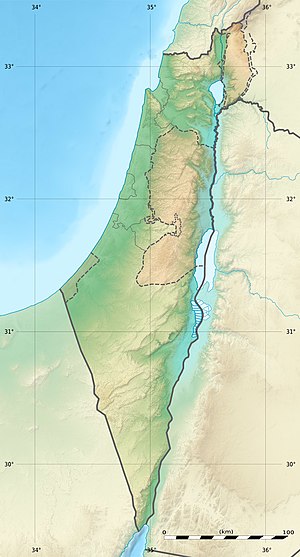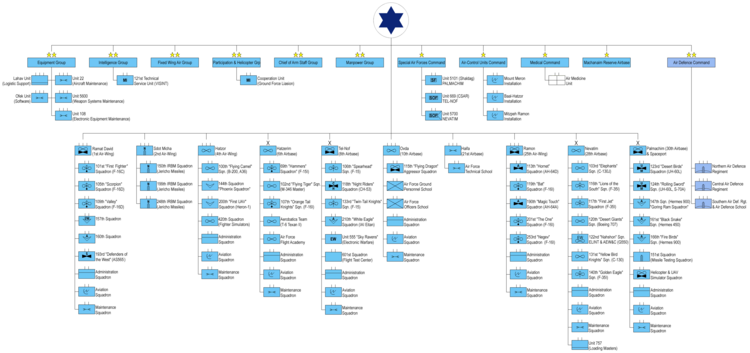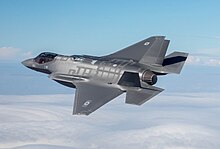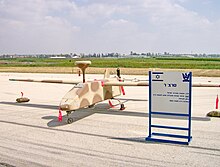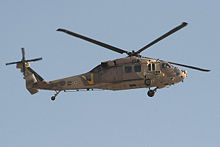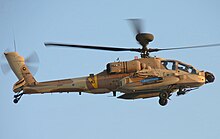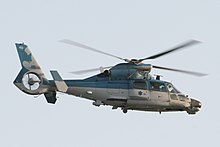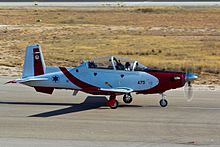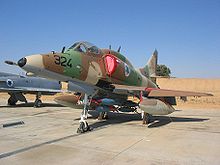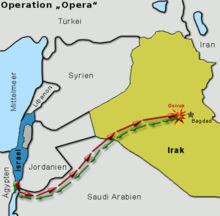Israeli Air Force
|
Israeli Air Force |
|
|---|---|

|
|
| Lineup | 1948 |
| Country |
|
| Armed forces | Israel Defense Forces |
| Type | Armed forces ( air force ) |
| management | |
| commander | Major General (Aluf) Amikam Norkin |
| insignia | |
| Aircraft cockade |
 
|
| flag |

|
The Israeli Air Force ( Hebrew חיל האוויר והחלל Cheil ha-Avir we-ha-Chalal , German for 'aerospace forces ' , English Israel Air Force , IAF for short ) are the air force of the Israeli armed forces . Since the IAF was founded during the 1948 War of Independence , they have played a major role in most of the hostilities in which Israel has participated.
assignment
The mission of the Israeli Air Force includes securing the territorial integrity of Israel , air defense and the provision of the air component of the Israeli armed forces in the main areas of operation of the Mediterranean in the west and in the Gulf of Aqaba , in the airspace over the Red Sea and over the Gulf of Suez in the south.
Facilities
- Haifa Airport (technician training)
- Ramat David Air Base ( F-16C / D , Eurocopter Dauphin )
- Palmachim Air Force Base ( UH-60 Black Hawk transport and rescue helicopters, drones, rocket launches)
- Tel Nof military airfield ( F-15C / D , CH-53D transport and rescue helicopters, drones, flight test center)
- Chazor Air Base (F-16C / D, flight simulator network, David's Sling missile defense system )
- Sdot Micha Air Force Base ( Jericho-2 and Jericho-3 missiles , Arrow-3 missiles )
- Chazerim military airfield ( F-15I , F16I , M-346 jet trainer , IAF flight academy , IAF aerobatic team , IAF museum )
- Nevatim Military Airfield ( F-35I , Boeing 707 tanker, C-130 transport aircraft, G550 CAEW )
- Ramon Air Base (F-16I, AH-64A / D Apache attack helicopter)
- Military Air Base Ovda (F-16C / D Aggressor Training Squadron, Ground Staff School, Officers School)
organization
equipment
Active aircraft
IAF equipment is among the most modern in the world. On August 15, 2010, the Israeli Defense Minister, Ehud Barak, gave his consent to the purchase of around 20 F-35I machines. The investments including maintenance contracts and spare parts amount to at least 4 billion US dollars. The delivery is planned over a period of two years from 2015, two machines in 2015, eight in 2016 and another eight in 2017. It has since been announced that Israel will buy at least 50 of the F-35I jets, which corresponds to two seasons. Some sources speak of up to 75 copies.
Here is an overview of the machines currently in use:
The aircraft are now mainly made in the USA. The aircraft delivered by the USA are mostly optimized by the IAF . The modifications made in Israel actually made it possible to increase performance in some cases, for example the F-16I has a greater range and a higher armament mass than the American version.
- 127 × Lockheed-Martin F-16C / D Block 40 (Israeli name "Barak", Hebrew for "lightning")
- 97 × Lockheed-Martin F-16I Block 50/52 (Israeli name "Sufa", Hebrew for "storm")
- 36 × McDonnell Douglas F-15 C / D Eagle (Israeli name "Baz", Hebrew for "falcon")
- 25 × McDonnell Douglas F-15I (Israeli name "Ra'am", Hebrew for "thunder")
- 18 × Lockheed Martin F-35 I (Israeli name "Adir", Hebrew for "The Mighty", since December 12, 2016 A total of 50 ordered, another 25 planned)
Transport machines
- 11 × Lockheed C-130 E / H "Karnaf" ("Hercules")
- 4 × Lockheed KC-130H "Karnaf" ("Hercules", tanker for helicopters)
- 6 × Lockheed C-130J "Samson" ("Super Hercules" and two more ordered)
- 22 × Raytheon-Beech King Air 200 "Tsofit"
- 9 × Boeing 707 "Re'em" (tanker)
Electronic aircraft
- 2 × Gulfstream G550 "Aitam" (serves as a "Conformal Airborne Early Warning" aircraft)
- 3 × Gulfstream V "Shavit" (serves as a SIGINT aircraft)
- 6 × Raytheon-Beech RC-12D / K "Railguard" (Israeli name "Kookiya")
Drones
- IAI Heron-TP / "Eitan"
- IAI Heron / "Shoval"
- Elbit Hermes 450 S "Zik"
- 2 × Elbit Hermes 900
Training aircraft
- 30 × Alenia Aermacchi M-346 "Lavi" (delivered until the end of 2016)
- 17 × Grob G-120AI "Snunit"
- 20 × Beechcraft T-6 A "Texan II" (Israeli name "Efroni")
- 17 × Boeing AH-64A "Peten" (some have been converted to "Sharaf")
- 21 × Boeing AH-64D-I "Sharaf"
Multipurpose helicopter
- 10 × Sikorsky UH-60 A "Yanshuf I" (used UH-60A of the US Army )
- 15 × Sikorsky S-70A-50 "Yanshuf II"
- 24 × Sikorsky S-70A-55 "Yanshuf III" (brand new UH-60L)
- 18 × Sikorsky CH-53A "Yasʾur 2000"
- 5 × Eurocopter AS 565MA "Atalef"
- 34 × Bell 206 Jet Ranger / Bell 206 Long Ranger "Saifan" or "Saifanit"
Spacecraft
The IAF also reports a small number of Israeli spacecraft :
- Amos (1, 2) - communications satellite
- EROS (A, B, C) - mineral treasure hunt satellite
- Ofeq (1, 2, 3, 4, 5, 6, 7) - reconnaissance satellite
- Shavit - launcher
Nuclear surface-to-surface missiles
The IAF operates the following missiles that can be armed with nuclear warheads, but Israel does not comment on this:
Anti-aircraft and missile defense
In air defense and missile defense , after the American Patriot air defense systems had proven to be largely worthless in the Iraqi R-17 attacks on Tel Aviv in 1991 , the IAF worked with US companies to develop new and more powerful systems.
The result is David's Sling and Arrow missile defense systems , while the Iron Dome system was developed by Israel alone.
Airborne weapon systems
The following airborne weapon systems are used by the Air Force:
-
Air-to-air missiles :
- Raytheon AIM-9 Sidewinder
- Raytheon AIM-120 AMRAAM
- Raytheon AIM-7 "Sparrow"
- Rafael "Python 4/5"
- Rafael Derby
- Rafael Black Arrow (missile as a training target for defense against ballistic missiles by ground-based anti-aircraft guided missiles)
-
Air-to-surface missiles :
- Rafael Popeye / Popeye Lite / Popeye Turbo
- IMI Delilah
- Spice
- NTD
- MSOV
- TALD / ITALD (decoys)
-
Free fall bombs :
- IAI "Griffin" (steering kit for Mk.83 / 84 LDGP)
- IMI ATAP (cluster bomb)
- GBU-31/32 JAM
- GBU-39 SDB
- GBU-28 Bunker Buster
- GBU-15
- GBU-10/12/16 "Paveway II" LGB
-
Anti-ship missiles :
- Rafael Gabriel
history
Emergence
The IAF has its origins in 1945. When the victory of the Allied troops in World War II was imminent, nine members of the Palmach , the paramilitary offshoot of the Hagana, received flight training in the Aviron flight school. On November 10, 1947 it was decided to build up regular air forces, the "Scherut Avir" (Air Service). All Jewish pilots were asked to register. There were also many seasoned WWII veterans among the pilots. The "Scherut Avir" was officially founded on December 27, 1947. The majority of the few available aircraft - mainly remnants from the Soviet , American and British air forces - were brought to Sde Dow (near Tel Aviv ). For this, many runways and taxiways had to be provisionally created in a very short time. Between December 1947 and May 1948, new aircraft were procured, mainly from the USA and Europe - the first of all aircraft were a derivative of the Messerschmitt Bf 109 , the Czech Avia S-199 , of which 25 were delivered (see Operation Balak ). Both Jewish and non-Jewish pilots from around the world volunteered to serve with the new air force. At the beginning of May 1948, the first pilots were trained on the Avia S-199 at Planá airfield in Czechoslovakia . After the official establishment of the state of Israel, the "Sherut Avir" was renamed to the name "Cheil Avir", which is still valid today.
War missions
1948: War of Independence
In the UN resolution of November 29, 1947, a division of the British mandate area " Palestine " into an Israeli and a Palestinian state was provided. The Arab states of Egypt , Syria , Lebanon , Transjordan , Saudi Arabia and Iraq rejected this. The trigger for the Palestine War was the Israeli declaration of independence on May 14, 1948, whereupon the five Arab states attacked the newly founded State of Israel a few hours later.
At first the Israelis saw no chance against the Arab troops; Tel Aviv was bombed continuously. The inadequately equipped IAF, however, was soon able to achieve success against the Arab air forces. Shortly afterwards, the IAF was called in to support the ground troops and thus contributed significantly to turning the course of the war.
1956: The Suez War
The Suez Crisis began with the nationalization of the Suez Canal by President Gamal Abdel Nasser . After Great Britain , France and Israel had formed a coalition in several secret talks to take action together, Israel attacked Egypt on October 29, 1956. The IAF had to destroy the task of communicating the Egyptian levels of command in the early phase. In the course of this operation, the Israeli Air Force succeeded in cutting off almost all enemy communications in Sinai .
At the same time, 16 DC-3 transporters brought 295 paratroopers to the Mitla Pass in Sinai, the largest paratrooper operation in Israeli history to date .
In the course of the aerial battles, the IAF managed to shoot down seven Egyptian aircraft without suffering any losses. The IAF made a significant contribution to disrupting Egyptian supply lines outside of Sinai. B-17 bombers from World War II were also used in these attacks .
However, a total of 15 Israeli ambulance pilots who were used to pick up the parachute troops were shot down.
1967: The Six Day War
In response to the closure of the Strait of Tiran to Israeli shipping, the forced withdrawal of UNEF troops from Sinai by Nasser, and the Egyptian deployment of 1,000 tanks and nearly 100,000 soldiers on Israel's borders, Israel launched a pre-emptive strike on June 5, 1967 against the Arab states through ( Six Day War ). The IAF attacked bases of the completely unprepared Egyptian air forces and achieved their complete destruction within three hours. Shortly afterwards, the air forces in Syria, Jordan and Iraq were attacked and also almost completely destroyed.
After the IAF had won the air sovereignty, it began to support the ground forces from the air. A total of 391 jets were destroyed on the ground, 26 air force bases were bombed inoperable and 60 enemy fighter jets were shot down in aerial battles. Parachutists were also used to conquer the Golan Heights .
The operation Moked is still a matter for tactical training courses of most modern air forces.
1968–1970: The War of Attrition
The so-called War of Attrition was started by Egypt to recapture Sinai , which Israel had conquered in the Six Day War. The war ended in 1970 with an armistice ; neither party has gained territory.
The new A-4 "Skyhawk" and McDonnell F-4 fighter jets proved extremely powerful because they were able to target more weapons.
The IAF flew over a thousand sorties along the Suez Canal and penetrated deep into Egyptian territory. In June 1969, for the first time since the Six Day War, air battles broke out between Israeli jets and new Egyptian MiGs (mainly MiG-21s ) that had just been delivered from the Soviet Union . In the course of these aerial battles, all nine MiG-21s were shot down.
In early September 1969, the IAF began SA-2 Guideline - anti-aircraft batteries to bomb, were to all Egyptian air defenses destroyed. A new tactic was used in which Israeli fighter bombers swooped above the target tracking radar cone of the Arab SAM positions and thus succeeded in deliberately destroying the air defense positions. In order to force Egypt to end the war, strategic goals were also fought in Egypt. In a whole series of attacks between January and April 1970, 118 such missions were flown. Their targets were radar stations , missile batteries and army bases throughout Egypt.
After Egypt could no longer oppose these attacks, the Soviet Union intervened with its own planes and pilots. On July 30, 1970, there was massive aerial combat between the IAF and Soviet pilots, but the outcome was even.
A total of about 98 enemy aircraft were shot down during the conflict. According to its own information, the IAF only lost eleven machines.
1973: The Yom Kippur War
The Yom Kippur War began on October 6, 1973 with a surprise attack by Egypt and Syria on the Sinai and the Golan Heights. In the first phase of the war, the IAF was tasked with securing Israeli airspace and stopping the advancing ground forces of the attackers.
In the course of the war, not a single enemy aircraft managed to penetrate Israeli airspace. However, the IAF had to pay a high price for this, because in a single day, October 7th, six IAF jets were destroyed over the Syrian front. In contrast, Israeli pilots managed to destroy 32 missile batteries in Egypt and seriously damage another 11.
When the Israeli Defense Forces responded, the IAF was deployed on both the Egyptian and Syrian fronts and managed to destroy several aircraft on the ground. In this way, the enemy air operations could be stopped almost entirely.
On October 9th, in retaliation for the launching of surface-to-surface missiles on Israeli civilian targets, the Syrian High Command was bombed in the center of Damascus . The IAF also destroyed the bridges over the Suez Canal.
For the first time, helicopters also played a central role in the fighting. They were used, for example, to rescue wounded pilots from enemy-controlled areas. In addition, elite units were deployed behind enemy lines and heavy artillery was transported to the front.
In total, around 300 Egyptian and over 150 Syrian jets were shot down during the war. According to Israeli information, the losses on their own side amounted to only around 100 IAF jets and around 60 crews captured or killed.
1982: The first Lebanon War
Since the PLO repeatedly launched attacks on Israel after its establishment in southern Lebanon , Israel began the first Lebanon War on June 6, 1982 (second see Lebanon War 2006 ).
The PLO responded with heavy artillery and rocket fire into northern Israeli settlements.
Operation Peace for Galia was launched on June 6, during which the Israeli Defense Forces managed to advance to Beirut within a very short time .
During the advance, helicopters were used on a massive scale, especially combat helicopters of the AH-1 Cobra type . In addition, the IAF supported the ground troops of the Israeli armed forces with its fighter-bombers and destroyed artillery positions, reconnaissance posts and armored vehicles of the enemy.
On June 9, 19 Syrian anti-aircraft missile sites were attacked and almost all of them were destroyed.
In fierce aerial battles against Syrian fighter jets, 29 enemy aircraft - mainly MiG-23s - were shot down (according to Israeli information). In total, around 100 enemy aircraft were destroyed without suffering any losses. This Israeli representation is also viewed critically by chroniclers.
Other missions
1969: Capture of the P-12 radar system
One of the IAF's most successful operations was the capture of a new Soviet radar system from Egypt.
The P-12 radar system was the most modern that the Egyptians got from the Soviets and used during the War of Attrition (1968–1970) against the Israelis. The system was identified on a reconnaissance photo from a height of 10,000 m, and on December 26, 1969, three helicopters with paratroopers and two transport helicopters were sent across the Suez Canal to capture the radar system. At the same time, the IAF flew a diversionary attack on Egyptian positions.
The soldiers were dropped six kilometers from their destination. They reached their destination at 1:30 a.m., secured the radar system and prepared it for transport in the helicopters.
The transport helicopters left their base in Israel at 2:30 a.m. and reached the radar station at 3:00 a.m. Then began to lift the radar system into the air. Since the helicopters were designed for a transport of 2.9 tons, but the radar system weighed 4.3 tons, the primary hydraulic system of the main transporter failed at takeoff.
However, the helicopter pilot ignored the emergency warning that prompted him to land immediately and brought the mission to a close. He flew all the way at extremely low altitude, his flight officer operated the engines manually until the final landing. The helicopter crossed the Suez Canal with the help of its reserve system, and finally managed to land safely on Israeli soil with the captured radar system.
1969: Sonic boom over Nasser's house
In order to demonstrate to the Egyptian head of state Gamal Abdel Nasser his vulnerability in the war of attrition, three Israeli F-4E "Kurnass" fighter-bombers (Phantom II) penetrated undisturbed through enemy airspace to Cairo on September 16, 1969 and broke through at 6:00 am Clock in the morning at Heliopolis over Nasser's house in the low flight the sound barrier . The windows of the house were destroyed in order to show Nasser that the IAF can attack targets anywhere over Egypt without hindrance. Nasser then ordered the dismissal of the Egyptian air force commanders.
1981: The attack on the Iraqi nuclear facility
On June 7, 1981 at around 5:30 pm, Israeli F-16 “Fighting Falcon” fighter-bombers bombed the Iraqi Osirak nuclear facility near Baghdad , about 1,000 kilometers from Israel, during Operation Opera .
The jets were escorted by a group of F-15 "Eagle" and flew undetected through Jordanian, Saudi Arabian and Iraqi airspace. The reactor was viewed by the Israeli government as the most serious threat, as the then Iraqi dictator Saddam Hussein was on the verge of manufacturing nuclear weapons and even announced it publicly.
The construction of the reactor in the form of a concrete pyramid made an air attack much more difficult. The attack had to be from below and the bombs had to be dropped in an upward-pointing parabolic trajectory in order to penetrate the concrete slabs, which were also pointing upwards. Despite these aggravating conditions, the operation succeeded and there were no losses on the Israeli side in this attack.
1987-2005: Intifada and al-Aqsa Intifada
Since the beginning of the First Intifada in 1987, the IAF has been used extensively in retaliation for terrorist attacks. The helicopters play a central role here. The numerous civilian victims of these attacks are severely criticized by the world public.
2007: Operation Orchard
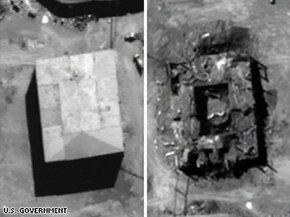
On September 6, 2007, the Israeli Air Force launched an attack on a structure in Syria (" Operation Orchard ").
The IAEA published on May 24, 2011 that the destroyed facilities were "very likely" a nuclear reactor . Syria may or may not want to produce fissile material for the construction of an atomic bomb and thus become a nuclear power . On March 21, 2018, the Israeli Air Force confirmed that it had carried out the attack.
2018: First female commander
On August 7, 2018, an air force pilot who was officially referred to as "Major G." for safety reasons became the first female squadron commander of the air force. She will lead the 122nd Squadron, also known as the Nachschon Squadron, which is mainly responsible for aerial reconnaissance and early warning.
Former weapon systems
A selection of former weapons systems used by the Israeli Air Force:
- Avia S-199 (1947 to approx. 1955)
- Bristol Beaufighter (1948 to 1949)
- General Dynamics F-16 A / B (July 1980 to December 2016)
- F-4 Phantom II (September 1969 to May 2004)
- Mirage III (April 1962 to 1982)
- Nescher (May 1971–1981)
- Kfir (April 1975-1995)
List of commanders
| Surname | Term of office | particularities |
|---|---|---|
| Israel Amir | May - July 1948 | wasn't a pilot |
| Aharon Remez | July 1948 - December 1950 | - |
| Schlomo Shamir | December 1950 - August 1951 | was also the commander of the Israeli Navy and the Central Command |
| Chaim Laskow | August 1951 - May 1953 | did not come from the Air Force and later became the 5th Chief of Staff of the Israel Defense Forces |
| Dan Tolkowskie | May 1953 - July 1958 | - |
| Ezer Weizmann | July 1958 - April 1966 | later became the 7th President of Israel |
| Mordechai Hod | April 1966 - May 1973 | - |
| Benjamin Peled | May 1973 - October 1977 | - |
| David Ivry | October 1977 - December 1982 | - |
| Amos Lapidot | December 1982 - September 1987 | - |
| Avihu Ben-Nun | September 1987 - January 1992 | - |
| Herzl Bodinger | January 1992 - July 1996 | - |
| Eitan Ben Elijahu | July 1996 - April 2000 | - |
| Dan Chalutz | April 2000 - April 2004 | later became the 18th Chief of Staff of the Israel Defense Forces |
| Eljezer Schkedi | April 2004 - May 2008 | - |
| Ido Nehushtan | May 2008 - May 2012 | - |
| Amir Eschel | May 2012 - August 2017 | - |
| Amikam Norkin | August 2017 - | - |
literature
- Chaim Herzog: Wars for Israel. 1948 to 1984 . Ullstein, Frankfurt am Main / Berlin / Vienna 1984, ISBN 3-550-07962-1 .
- Peter Scholl-Latour : Lies in the Holy Land: Trials of Power between Euphrates and Nile . Munich 2000, ISBN 3-442-15058-2 .
- José Fernandez / Patrick Laureau / Alex Yofe: Between Purchase and Conspiracy - The History of the Development of the Israeli Air Force . In: Fliegerrevue extra . 30 and 31 - Part 1 and 2. Möller, 2010.
Web links
- Official site of the Israeli Air Force (English)
- Israel Air Force Enthusiasts (English)
- Israel Air Force (Aeroflight) (English)
- Israel Air Force / Defense Force (Scramble) ( Memento from October 21, 2000 in the Internet Archive ) (English)
Individual evidence
- ↑ second-iaf-f-35-squadron-to-be-inaugurated - jpost.com , accessed on August 9, 2020
- ↑ jpost.com
- ↑ FOCUS Online: So they want to fight against IS now - Israel is expanding air force fleet - video. December 12, 2016, accessed March 22, 2020 .
- ↑ Arie Egozi: Israeli paratroops make first jump from C-130J. In: Flightglobal.com. February 6, 2015, accessed on February 6, 2015 (English): "Thirty cadets from the parachuting instruction course of the Flight and Special Training Center (FSTC) jumped from the C-130J" Samson ". [...] Flightglobal's Ascend Fleets database records the Israeli air force as having so far received two of the four C-130Js on firm order. It also has options and letters of interest in place to acquire another five of the type. "
- ↑ The first M-346 arrive in Hatzerim. Flug Revue, July 9, 2014, accessed July 10, 2014 .
- ↑ missilethreat.csis.org
- ↑ iaf.org.il
- ↑ tagesschau.de , May 24, 2011, Syria apparently built a secret nuclear reactor ( Memento from May 25, 2011 in the Internet Archive )
- ↑ Israel pledges to attack Syrian nuclear reactor in 2007. March 21, 2018, accessed April 7, 2020 .
- ↑ Luftwaffe appoints a female commander for the first time. In: Israelnetz.de , August 8, 2018, accessed on August 10, 2018.
- ^ Bristol Beaufighter. In: Fighters. Israeli Air Force, accessed on November 29, 2013 (English): "A film shoot that changed history"
